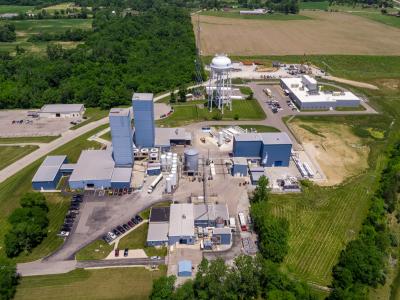The following is a sponsored post by Cambridge Isotope Laboratories
OLED has become the display technology of choice for many commercial products such as smartphones, laptops, tablets, TVs, automotive dashboards and wearables. OLED has advantages with improved image quality (better contrast, higher brightness, fuller viewing angle, wider color range, and faster refresh rates), lower power consumption, and simpler designs (ultra-thin, flexible, foldable, and transparent displays).
Cambridge Isotope Laboratories plant in Xenia, OH, USA
OLED, however, faces several technical challenges. While OLED TVs yield better picture quality than common LCDs, they are usually less bright. Research using a compound that has at least one hydrogen replaced with its heavier isotope, deuterium, is showing promise toward achieving greater brightness. Since the bonds between carbon and deuterium are stronger than those between carbon and hydrogen, materials made with deuterated compounds tend to have a longer lifetime, which allows OLED displays to run brighter but still last as long.
Recent advances in R&D and improved manufacturing have significantly increased the longevity of OLED displays. Deuterium is already being used in novel OLED manufacturing processes and R&D, as it was found to grant stabilization properties. Due to a neutron's presence, the atomic mass of deuterium is twice as much as protium – the most common isotope of hydrogen. Therefore, deuterium’s bond lengths and bond energy are also different from those of protium. These changes are known as kinetic isotope effects (KIE).
Deuterated compounds are used in OLED components responsible for the emission of blue light. These blue light-emitting components tend to degrade the fastest, because the inherent nature of blue light has a high frequency. Relying on the deuterium KIE, the lifetime of these components can be extended by five- to 20-fold and improve the efficiency of an OLED device.
Researchers have found that replacing hydrogen with deuterium during the final wafer sintering process of OLED production can significantly reduce hot electron degradation effects in metal oxide semiconductor transistors due to a new giant isotope effect. Transistor lifetime improvements by factors of 10-50 can be observed in other areas of semiconductor device processing and fabrication.
Deuterium is present in natural water at a ratio of one deuterium atom for every 6,400 hydrogens; however, there are few heavy-water production facilities to concentrate deuterium-containing water (D2O). Cambridge Isotope Separations (CIS) in Xenia, OH, a fully owned subsidiary of Cambridge Isotope Laboratories (CIL) houses the world’s largest commercial D2O enrichment columns. This gives CIS the unique ability to re-enrich D2O (deuterium oxide), which allows the recycling of used or unused D2O.
Other deuterated compounds are used in electronics manufacture, such as deuterated benzene, which has been proven to increase performance. By harnessing the KIE, manufacturers can produce better-performing electronics, faster microprocessors, and see an increased life span of their devices, including OLED screens. Bromobenzene-d5 is used in the manufacturing of electronic components and OLED displays.
As the world’s largest non-nuclear consumer of D2O, CIL continues to be the leading producer of deuterated NMR (nuclear magnetic resonance) solvents and deuterated reagents for analytical and synthetic applications.
